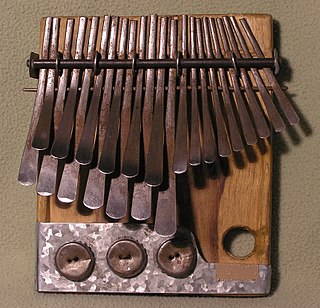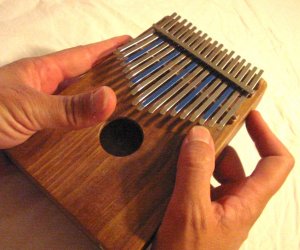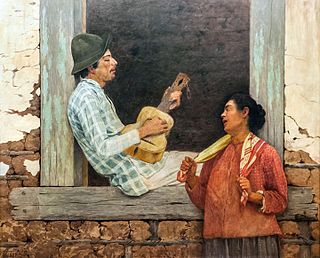Throughout history, various methods of musical instrument classification have been used. The most commonly used system divides instruments into string instruments, woodwind instruments, brass instruments and percussion instruments; however, other schemes have been devised.

The traditional music of Africa, given the vastness of the continent, is historically ancient, rich and diverse, with different regions and nations of Africa having many distinct musical traditions. Music in Africa is very important when it comes to religion. Songs and music are used in rituals and religious ceremonies, to pass down stories from generation to generation, as well as to sing and dance to.

Zimbabwean music includes folk and pop styles. Much of the folk music incorporates mbira, Ngoma drums and hosho. Music has played a significant role in the history of Zimbabwe, from a vital role in the traditional Bira ceremony used to call on ancestral spirits, to protest songs during the struggle for independence.

The hosho are Zimbabwean musical instruments consisting of a pair of maranka (mapudzi) gourds with seeds. They typically contain hota seeds inside them. The hosho are used to accompany Shona music, especially mbira music. They make a rattling sound that western ears may be unaccustomed to hearing. However, this accompaniment is essential when playing mbira and/or marimba music. So essential, in fact, that extra vibrating elements such as mirlitons are attached to the resonating tubes of marimbas and machachara are attached to the mbira and its deze. Mbiras and marimbas from Africa; and even other instruments, such as drums, will have some kind of rattles associated with their use.

A lamellophone is any of a family of musical instruments. The name comes from the Latin word lamella for "small metal plate", and the Greek word φωνή phonē for "sound, voice".
Shona music is the music of the Shona people of Zimbabwe. There are several different types of traditional Shona music including mbira, singing, hosho and drumming. Very often, this music will be accompanied by dancing, and participation by the audience. In Shona music, there is little distinction between the performer and the audience, both are often actively involved in the music-making, and both are important in the religious ceremonies where Shona Music is often heard.

A folk instrument is a musical instrument that developed among common people and usually does not have a known inventor. It can be made from wood, metal or other material. Such an instrument is played in performances of folk music.
Ephat Mujuru (1950–2001), was a Zimbabwean musician, one of the 20th century's finest players of the mbira, a traditional instrument of the Shona ethnic group of Zimbabwe.
Abraham Dumisani Maraire, known to friends as "Dumi", was a master performer of the mbira, a traditional instrument of the Shona ethnic group of Zimbabwe. He specialized in the form of mbira called nyunga nyunga, as well as the Zimbabwean marimba. He introduced Zimbabwean music to North America, initiating a flourishing of Zimbabwean music in the Pacific Northwest that continues into the 21st century.

Ngoma are musical instruments used by certain Bantu populations of Africa. Ngoma is derived from the Kongo word for "drum". Different Bantu-inhabited regions have their own traditions of percussion, with different names for their instruments. In Kikongo, "ngoma" is used by extension to signify specific dances, social occasions and rhythms.

Hugh Travers Tracey was an English ethnomusicologist. He and his wife collected and archived music from Southern and Central Africa. From the 1920s through the 1970s, Tracey made over 35,000 recordings of African folk music. He popularised the mbira internationally under the name kalimba. The kalimba is most similar to the mbira nyunga nyunga, but varies substantially from the more popular mbira dzazadzimu which is a fundamentally different instrument.

Andrew Tracey, born 5 May 1936, Durban, South Africa, is a South African ethnomusicologist, promoter of African Music, composer, folk singer, band leader, and actor. His father, Hugh Tracey (1903–1977), pioneered the study of traditional African music in the 1920s – 1970s, created the International Library of African Music (ILAM) in 1954, and started the company African Musical Instruments (AMI) which manufactured the first commercial kalimbas in the 1950s. Andrew Tracey continued and complemented the work of his father Hugh Tracey in a variety of ways. With brother Paul Tracey, he co-wrote and performed in the world musical revue Wait a Minim! which travelled around the world for seven years. With his father and brother Paul, Andrew wrote the first instructional materials for the Hugh Tracey kalimbas which were being sent around the world in the 1960s. Upon his father's death in 1977, Andrew took over his father's role as director of ILAM, which he filled until his retirement in 2005, and his wife Heather Tracey took over the role of director of AMI until 1999.
Queen Marimba is a folk hero whose accomplishments have become part of the folklore of Africa. As is customary in most African cultures she is considered to be a god and was one of the immortals. There has been scant research done on her and presently the most notable source for information on her life comes from the writings of Vusa'mazulu Credo Mutwa. Various renditions of his book have been published since the late 60's, including "My People, My Africa", "Indaba My Children" and "Africa Is My Witness."
Oopoochawa or Opochawa, also known as quisanche is a type of mbira or lamellaphone from South America, popular in the areas of Montevideo, Uruguay and La Plata, Argentina.

Ikembe, is a type of musical instrument of the lamellaphone group, common amongst the Bahutu of Rwanda, Burundi and the Congo. The instrument consists of several iron lamellae, fixed to a rectangular wooden soundbox.

The matepe is a type of lamellophone played in North-Eastern Zimbabwe. It is primarily played by the Sena Tonga and the Kore-Kore peoples which are subgroups of the Shona people.
Roneat is the generic Khmer word for referring to several types of xylophones used in traditional Cambodian music; the pinpeat and mahori.















